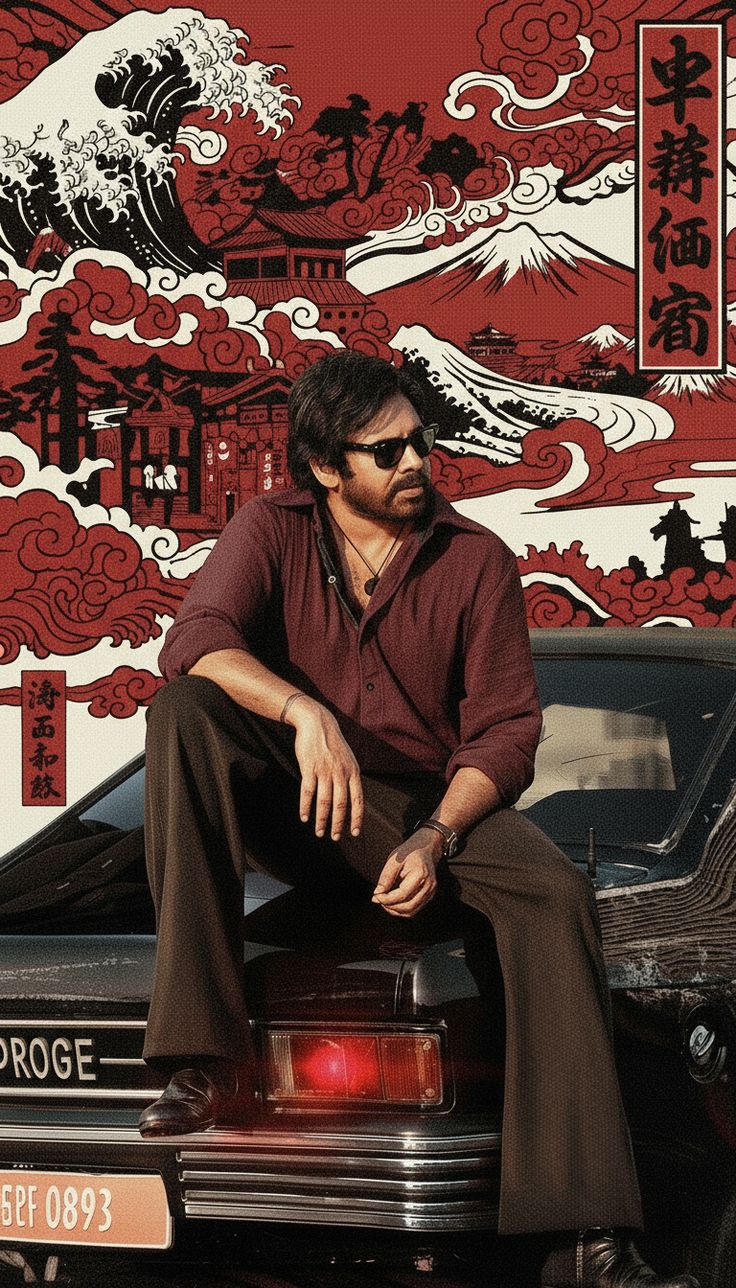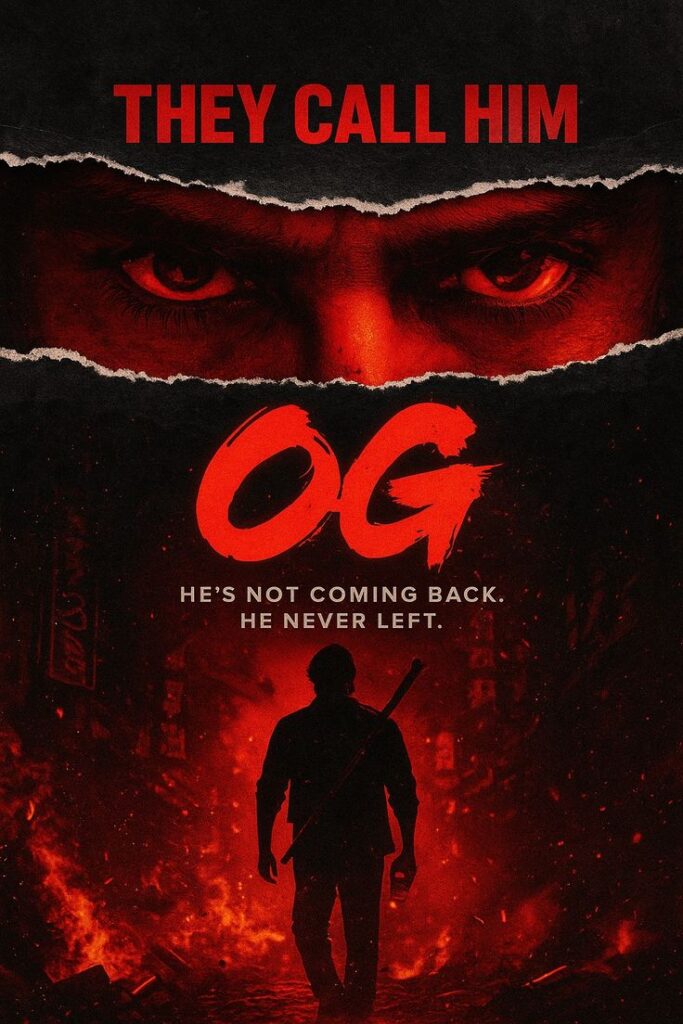When the clock struck midnight and the first shows of They Call Him OG rolled in, something unusual happened across Andhra Pradesh, Telangana, and beyond. Streets lit up with firecrackers, theatres transformed into stadiums, and fans roared as though their team had won the World Cup. This wasn’t just a film release—it was an event, a festival, and for countless admirers of Pawan Kalyan, it was a once-in-a-lifetime celebration.
Directed by Sujeeth, OG is a gangster saga told with the ferocity of a mass entertainer and the scale of an epic. But more than the film’s story or its filmmaking, what’s driving the conversation is the sheer force of Pawan Kalyan’s return to full-fledged cinema. For his fans, OG isn’t just a movie—it’s a reaffirmation of why they’ve stood by him through political diversions, industry breaks, and long absences.
The Legend of Ojas Gambheera
At the heart of OG is Ojas Gambheera, the character who resurrects Pawan Kalyan’s mass image in thunderous style. Ojas is a gangster-warrior who returns to Bombay after ten years in exile, his silence replaced with savage purpose. His mission: to bring down Omi Bhav, the ruthless underworld don played by Bollywood actor Emraan Hashmi in his much-anticipated Telugu debut.
The face-off is not merely a clash of characters but a collision of two cinematic worlds. For Telugu audiences, Emraan Hashmi stepping into the role of a feared crime lord is refreshing, while Pawan Kalyan’s larger-than-life entry as Ojas is a goosebump-inducing spectacle. The ramp title card, the heavy-duty dialogues, and the simmering showdown between these two powerhouses are the moments fans have been waiting for.
Sujeeth’s Vision: A Mass-Action Symphony
Sujeeth, who burst onto the scene with Saaho, has taken a radically different approach in OG. While Saaho leaned on stylish visuals and pan-India gloss, OG thrives on raw mass energy. Every frame screams celebration. From the electrifying opening fight to the explosive interval block, Sujeeth stages OG like a grand opera of action, where violence is not just spectacle but poetry in motion.
Thaman’s background score is another driving force. The composer has built a reputation for elevating star vehicles, but with OG, he outdoes himself. The sound design is thunderous, each beat carefully engineered to sync with whistles, claps, and cheers erupting in packed theatres. For many fans, the BGM isn’t just music—it’s a pulse that keeps the movie alive in their veins.
The Mass Moments: A Checklist of Madness
What defines a Pawan Kalyan film? It’s not simply story or acting. It’s the “mass moments”—those beats designed to make audiences lose control, stand on their seats, and scream. OG is packed with them:
The Ramp Title Card: A scene that reintroduces Ojas Gambheera with gravity, backed by a slow-burning BGM that explodes into chaos.
The Interval Fight: Choreographed with gritty intensity, it feels like Pawan Kalyan announcing, “I am back.”
The Dialogues: Minimal yet impactful, Ojas doesn’t waste words—he lets his silences speak louder than his fists.
Every one of these sequences has become a talking point online, where fans upload reaction videos showing theatres erupting as if a rock concert were underway.
A Celebration Beyond Storytelling
For casual viewers, OG might read as an action crime drama. For fans, however, it is an emotional pilgrimage. Each frame is less about the narrative and more about validation. After years of waiting, seeing their idol return to the big screen in a role tailored to his aura is pure catharsis.
Pawan Kalyan has always commanded loyalty like few stars in Indian cinema. His political career and intermittent filmography only deepened that bond. With OG, fans aren’t just watching a film; they’re celebrating their own resilience, their unwavering faith in their hero.
The Off-Screen Drama
Interestingly, the frenzy around OG wasn’t limited to on-screen fireworks. The film had its fair share of off-screen controversies and hurdles, especially around its overseas release.
A delay in shipping content to international distributors left fans in the US and Canada anxious. At one point, major cinema chains in North America even delisted the film temporarily, and the Tamil version’s release was scrapped altogether in certain regions. Social media was flooded with worried posts and frustrated comments.
But instead of dampening the hype, these hiccups added to the frenzy. Fans organized petitions, demanded answers from distributors, and created hashtags that trended globally. In a strange twist, the chaos only amplified the film’s aura—it was as if even obstacles couldn’t stop the storm of OG.
Emraan Hashmi’s Telugu Leap
While Pawan Kalyan is the film’s beating heart, Emraan Hashmi’s entry into Telugu cinema cannot be overlooked. Playing Omi Bhav, the sinister antagonist, Hashmi dials up his performance with icy menace. Known in Bollywood for his romantic and intense roles, his transformation into a gang lord has been widely praised.
For Telugu cinema, this casting choice is significant. It reflects the industry’s growing pan-India appeal and its ability to attract big names from across regions. Hashmi himself admitted in interviews that he was “blown away” by the scale of OG and the energy of Telugu fandom. His performance ensures that Omi Bhav isn’t just another villain, but a formidable nemesis worthy of Ojas Gambheera.
The Ensemble Cast: More Than Just Add-ons
Beyond the leads, OG boasts a stellar supporting lineup. Priyanka Mohan plays a crucial role that balances the film’s intensity with emotional depth. Arjun Das, known for his distinct voice and screen presence, adds layers of menace. Shriya Reddy and Prakash Raj, veterans of their craft, ground the narrative with gravitas.
Together, they prevent the film from becoming a one-man show. Their performances enhance the world of OG, making it richer, more immersive, and more engaging.
Theatres as Stadiums: Fan Frenzy at Its Peak
No account of OG would be complete without acknowledging the fan frenzy. Videos from premiere shows reveal fans showering cutouts with milk, dancing in aisles, and breaking into chants that could rival a cricket stadium.
From Hyderabad to Vijayawada, from Bengaluru to Chennai, OG screenings became carnival grounds. In Mumbai and Delhi, Telugu associations booked out entire theatres. In the US, fans braved last-minute cancellations and drove miles to find alternative screenings.
On social media, hashtags like #TheyCallHimOG and #PawanKalyanMass returned to the trending charts. Memes, reaction clips, and fan edits flooded platforms, turning the film into a digital spectacle as much as a theatrical one.
Pawan Kalyan: More Than a Star, A Sentiment
To understand OG, one must understand Pawan Kalyan’s place in Telugu culture. He is not merely an actor—he’s an ideology, a sentiment, a symbol of defiance and hope. His fans call him “Power Star” with reverence, and that energy spills into every theatre he graces.
His absence from films due to political commitments only magnified this aura. When he does return, as in OG, it feels less like a performance and more like a reunion. Audiences don’t just watch him—they celebrate him.
What OG Means for Telugu Cinema
In the bigger picture, OG is also a marker of where Telugu cinema stands today. Post-Baahubali and RRR, the industry has embraced a pan-Indian identity. OG, while firmly rooted in Telugu mass traditions, is packaged with a cinematic language that appeals across regions.
The presence of Emraan Hashmi, the pan-Indian release strategy, and the film’s universal gangster theme make it accessible to wider audiences. Yet, it doesn’t compromise on the local flavor that fans crave. In that balance lies its real achievement.
The Road Ahead
With its box-office numbers climbing and its cultural impact undeniable, OG is likely to remain in the news for weeks. For Pawan Kalyan, the film reestablishes his position as one of Telugu cinema’s most bankable stars. For Sujeeth, it marks a creative redemption. For fans, it is a memory etched in their hearts—a reminder of why they light up theatres, organize rallies, and chant their hero’s name like a mantra.
A Storm Well Worth the Wait
They Call Him OG isn’t just another Friday release. It is proof of what happens when cinema collides with fandom, when a star returns to his roots, and when storytelling is fused with spectacle. It’s messy, loud, emotional, and unapologetically larger than life—exactly the way mass cinema should be.
For Pawan Kalyan’s fans, this storm was not just expected, it was inevitable. And as theatres continue to erupt with whistles, war cries, and tears of joy, one thing is clear: Ojas Gambheera has arrived, and with him, so has the revival of a legend.
Related News: Read More




